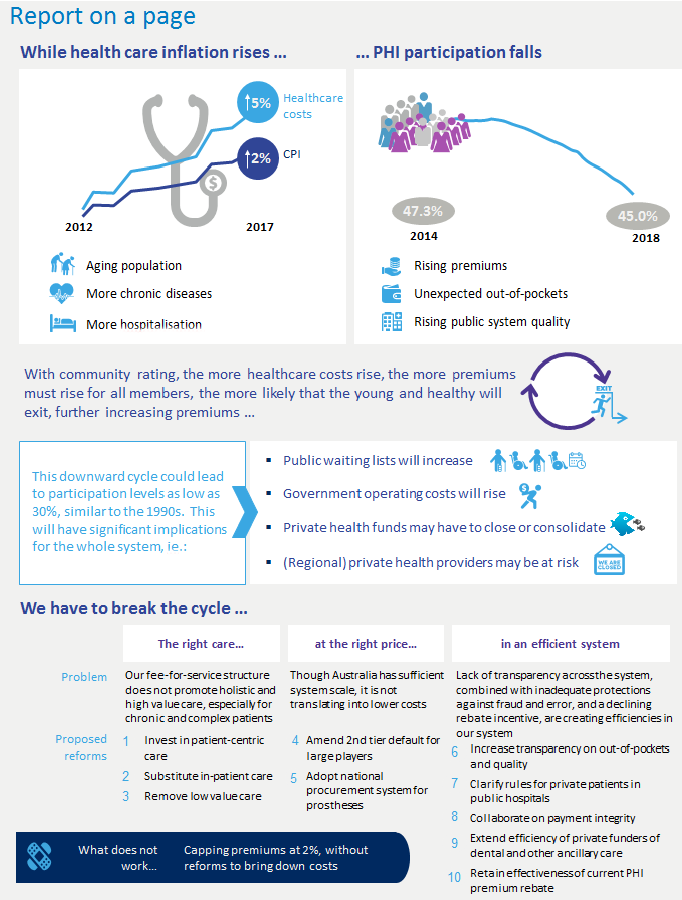Private Healthcare Australia (PHA) has proposed a number of key reforms to address the rising costs of healthcare and stem the movement of members to an already overburdened public health system. With healthcare costs rising by five percent annually, it is more important than ever for government to adopt the reforms to maintain the balance between the private and public healthcare sectors.
PHA Chief Executive Dr Rachel David said the reforms could reduce spending in the short term and halve healthcare inflation to just 2 to 3 percent p.a. over the long term, while maintaining high quality care and access. Dr David said these reforms would not only make private health more affordable for members but could deliver savings for areas of the Medicare system as well.
One of the key measures in PHA’s 2019-20 Budget Submission is the restoration of the PHI rebate to 30% for low and middle-income earners, or at a minimum, arrest the decline to maintain it at current levels.
“Financial incentives including the means-tested rebate are a proven way to promote participation and keep private cover more affordable for all Australians. PHA research has clearly demonstrated that the private health insurance rebate is a highly efficient way of funding non-emergency surgery and in-hospital mental health care,” [1] said Dr David.
“As of June 2018, 54% of the Australian population have a private health insurance policy, however without further reforms to address rising healthcare costs participation could drop to 30% by 2030-2035. This will result in longer hospital waiting times, and a shortage of beds for the people who need them most.”
Dr David said the success of the Coalition Government’s private health insurance reforms introduced in 2018 meant this year’s premium increase of 3.25% was much lower than it would otherwise have been and the lowest recorded for almost two decades.
“It is time the healthcare industry repeated the successful collaborative effort, started by the Coalition government and delivered by the 2018 PHI reforms. The reforms were two years in the making and developed by stakeholders from across the health system including health funds, medical professionals, hospitals and consumers groups. These reforms are proof that when industry works together, we can achieve more affordable outcomes for the 13.5 million Australians that choose to have private health cover.”
Another key issue the entire health industry must address to make healthcare more affordable is ensuring patients are provided with the “right care”, that is, providing services when they are needed to an appropriate standard – right patient, right setting, right time. To achieve this, there are simple measures that should be implemented:
- Removal of items from the Medicare Benefits Schedule (MBS) that experts agree are low value, wasteful or harmful, or the tightening of descriptors to evidence-based care;
- Permit health funds to provide funding for specific outpatient services to help consumers avoid accumulating co-payments;
- Reduce hospitalisations with more holistic patient-centric management of chronic and complex disease, including co-funding of prevention, home care and community-based options;
- Continue to work towards fair prices for medical devices in Australia through a national procurement strategy, which includes international reference pricing and price disclosure, and health technology assessment of new products to ensure we get the best quality and value for money for Australians.
Dr David said the only way to put downward pressure on premiums as utilisation goes up was to address wasteful input costs.
“Wasteful costs in the health system are not unique to the private sector, and they have multiple causes. Often this is down to health system design and regulations, which are not fit-for-purpose. This is why payors and providers need to work together towards improved outcomes for consumers.”
PHA is also proposing a more affordable and accessible dental health system. Through contracting with dentists and vertically integrating with dental practices, private health funds have been able to deliver cost relief to consumers through reduced out-of-pocket costs.
“Extending the efficiencies of private funders of dental care to the public sector could deliver further savings to the government. This can achieved by contracting out Commonwealth dental health program funding and enabling health funds to tender as service providers.” says Dr David.
Health funds are playing an increasingly important role in ensuring Australians have access to high quality dental care. One-in-two Australians claim for dental services through a health fund. Health funds pay out over $2.6 billion per annum in dental benefits, which is more than Federal Government dental programs.
“None of the proposed reforms are radical, they are sensible and necessary to ensure our health system continues to deliver high quality, accessible and affordable care for all Australians. Health funds are committed to delivering value for money by funding evidence-based care, at an affordable price,” said Dr David.
[1] Evaluate, The Relative Efficiency of the Private Health Insurance Rebate v Direct Public Health Expenditure, 2017
PHA’s complete Budget Submission 2019-20 can be accessed here.
Media Contact: Jen Eddy 0439 240 755

